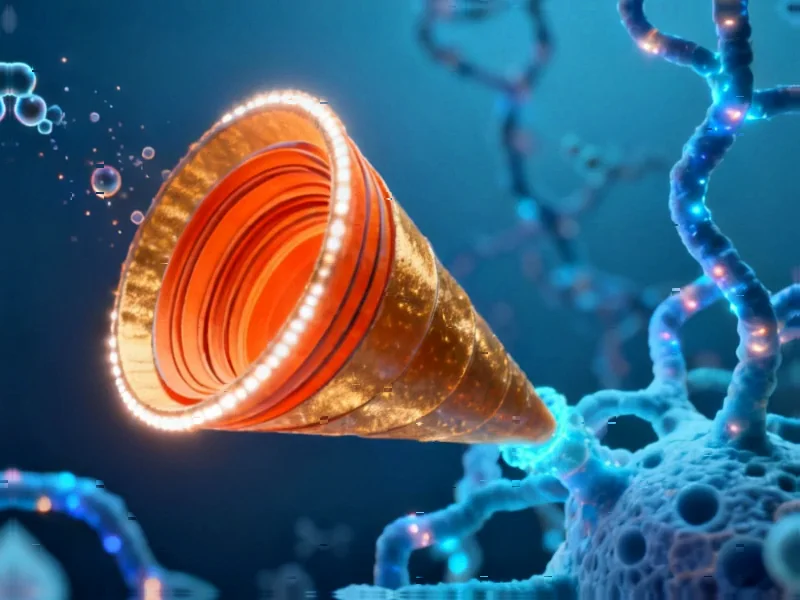The Electron Escape Conundrum
For decades, physicists have grappled with a fundamental question: what precisely determines whether an electron can escape a solid material? While the phenomenon of electron emission has been technologically exploited for years in everything from electron microscopes to semiconductor devices, the underlying theoretical framework has remained incomplete. Recent research from TU Wien has now identified the crucial missing component—quantum “doorway states” that serve as the essential exit pathways for escaping electrons.
Beyond the Energy Barrier
The conventional understanding suggested that electrons simply needed sufficient energy to overcome a material’s work function—the energy threshold keeping them bound. “One might assume that all these electrons, once they have enough energy, simply leave the material,” says Prof. Richard Wilhelm, head of the Atomic and Plasma Physics group at TU Wien. “If that were true, things would be simple: we would just look at the electrons’ energies inside the material and directly infer which electrons should appear outside.”
However, experimental results consistently contradicted this straightforward prediction. Researchers observed that materials with nearly identical electron energy distributions could produce dramatically different emission patterns. This discrepancy pointed to a deeper quantum mechanical reality governing electron escape processes.
The Doorway State Discovery
The breakthrough came when researchers realized that energy alone wasn’t sufficient. “From an energetic point of view, the electron is no longer bound to the solid. It has the energy of a free electron, yet it still remains spatially located where the solid is,” explains Wilhelm. The situation resembles a frog that can jump high enough to escape a box but fails to find the opening.
The research team identified specific quantum states that act as essential intermediaries between bound electrons and successful emission. “The electrons must occupy very specific states—so-called doorway states,” says Prof. Florian Libisch from the Institute for Theoretical Physics. “These states couple strongly to those that actually lead out of the solid. Not every state with sufficient energy is such a doorway state—only those that represent an ‘open door’ to the outside.”
This discovery represents a significant quantum breakthrough in understanding electron behavior at material interfaces.
Experimental Validation and Material Dependence
The research team employed sophisticated experimental techniques combined with theoretical modeling to verify the doorway state hypothesis. “For the first time, we’ve shown that the shape of the electron spectrum depends not only on the material itself, but crucially on whether and where such resonant doorway states exist,” says Anna Niggas from the Institute of Applied Physics at TU Wien, first author of the study published in Physical Review Letters.
Interestingly, the presence and characteristics of these doorway states vary significantly with material structure. In layered materials like graphene, certain doorway states only emerge when more than five layers are stacked. This structural dependence explains why materials with similar bulk electronic properties can exhibit completely different emission behaviors.
Technological Implications and Future Applications
The identification of doorway states opens new avenues for material design and optimization. By engineering materials to possess specific doorway state characteristics, researchers could develop:
- Enhanced electron sources with precisely controlled emission properties
- Optimized layered materials for electronic and photonic applications
- Advanced analytical techniques for material characterization
- Improved quantum devices leveraging controlled electron transport
This fundamental understanding could accelerate numerous industry developments in electronics and quantum technology.
Broader Scientific Context
The doorway state concept resolves long-standing inconsistencies in surface science and electron spectroscopy. For techniques like photoemission spectroscopy—which relies on measuring emitted electrons to determine material properties—accounting for doorway states will enable more accurate interpretation of experimental data.
This research also connects to broader market trends in quantum research and advanced materials development. As the field progresses, understanding these fundamental quantum mechanical processes will be crucial for developing next-generation electronic devices and quantum computing components.
Looking Forward
The TU Wien collaboration plans to extend their research to more complex material systems and explore how doorway states behave under different environmental conditions. “This is just the beginning,” notes Niggas. “We’re now investigating how these states form in various material classes and how we can deliberately create or suppress them for specific applications.”
The discovery underscores that even in well-established physical phenomena, fundamental quantum mechanical principles can reveal surprising new layers of complexity—and opportunity. As research continues, the doorway state concept promises to unlock new capabilities in material science and quantum technology development.
This article aggregates information from publicly available sources. All trademarks and copyrights belong to their respective owners.
Note: Featured image is for illustrative purposes only and does not represent any specific product, service, or entity mentioned in this article.



